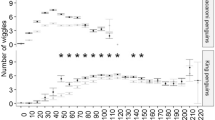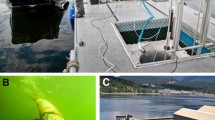Abstract
Pinnipeds give birth to their pups ashore or on ice and forage in water. Therefore, neonates initially lack the adaptations to sustain prolonged underwater diving activity. Although the physiological development for breath-holding during diving has been investigated in seal pups, little is known about the concurrent development of behavioral adaptations during lactation. In this study, multisensor data loggers were used to record diving behavior and swimming gaits of pre-weaned Weddell seal (Leptonychotes weddellii) pups. Experiments were conducted in 16 pups at the Syowa Station, Antarctica, from November to December 1999 and 2004. Swimming speeds, dive depths and flipper stroking rates were recorded for each individual for about 24 h. We found that the glide index during ascending was increased with body length, whereas the dominant stroke cycle frequency were not affected by body length, dive depth and descent or ascent phase. All pups had significantly higher stroke rates in descent than in ascent, but there was no difference between swimming speed. As we found a positive relationship between the body length and age, we considered body length as an index of growth. Therefore, we conclude that pups gradually acquire the ability to glide with utilizing positive buoyancy during ascending toward the end of lactation.



Similar content being viewed by others
References
Arnbom T, Fedak MA, Boyd IL, Mcconnell BJ (1993) Variation in weaning mass of pups in relation to maternal mass, post weaning fast duration, and weaned pup behavior in southern elephant seals (Mirounga leonina) at South-Georgia. Can J Zool Rev 71:1772–1781
Bowen WD, Boness DJ, Iverson SJ (1999) Diving behaviour of lactating harbour seals and their pups during maternal foraging trips. Can J Zool Rev 77:978–988
Burns JM (1999) The development of diving behavior in juvenile Weddell seals: pushing physiological limits in order to survive. Can J Zool Rev 77:737–747
Burns JM, Castellini MA (1996) Physiological and behavioral determinants of the aerobic dive limit in Weddell seal (Leptonychotes weddellii) pups. J Comp Physiol B 166:473–483
Burns JM, Testa JW (1997) Developmental changes and diurnal and seasonal influences on the diving behaviour of Weddell seal (Lepthonychotes weddellii) pups. In: Battaglia B, Valencia J, Walton DWH (eds) Antarctic communities. Cambridge University Press, Cambridge UK, pp 328–334
Burns JM, Costa DP, Frost K, Harvey JT (2005) Development of body oxygen stores in harbor seals: effects of age, mass, and body composition. Physiol Biochem Zool 78:1057–1068
Burns JM, Lestyk KC, Folkow LP, Hammill MO, Blix AS (2007) Size and distribution of oxygen stores in harp and hooded seals from birth to maturity. J Comp Physiol B 177:687–700
Butler PJ, Jones DR (1997) Physiology of diving of birds and mammals. Physiol Rev 77:837–899
Cherepanova V, Neshumova T, Elsner R (1993) Muscle blood-flow in diving mammals. Comp Biochem Physiol 106:1–6
Clark CA, Burns JM, Schreer JF, Hammill MO (2007) A longitudinal and cross-sectional analysis of total body oxygen store development in nursing harbor seals (Phoca vitulina). J Comp Physiol B 177:217–227
Gazo M, Lydersen C, Aguilar A (2006) Diving behaviour of Mediterranean monk seal pups during lactation and post weaning. Mar Ecol Prog Ser 308:303–309
Hindell MA, Lea MA, Morrice MG, MacMahon CR (2000) Metabolic limits on dive duration and swimming speed in the southern elephant seal Mirounga leonina. Physiol Biochem Zool 73:790–798
Horning M, Trillmich F (1997) Development of hemoglobin, hematocrit, and erythrocyte values in Galapagos fur seals. Mar Mammal Sci 13:100–113
Irvine LG, Hindell MA, van den Hoff J, Burton HR (2000) The influence of body size on dive duration of underyearling southern elephant seals (Mirounga leonina). J Zool 251:463–471
Jorgensen C, Lydersen C, Brix O, Kovacs KM (2001) Diving development in nursing harbour seal pups. J Exp Biol 204:3993–4004
Kanatous SB, Hawke TJ, Trumble SJ, Pearson LE, Watson RR, Garry DJ, Williams TM, Davis RW (2008) The ontogeny of aerobic and diving capacity in the skeletal muscles of Weddell seals. J Exp Biol 211:2559–2565
Kooyman GL (1989) Diverse divers: physiology and behavior. Springer, NY
Kusagaya H, Sato K (2001) A safe and practical inhalation anaesthesia for Weddell seals. Polar Biol 24:549–552
Le Boeuf BJ, Morris PA, Blackwell SB, Crocker DE, Costa DP (1996) Diving behavior of juvenile northern elephant seals. Can J Zool Rev 74:1632–1644
Lydersen C, Hammill MO (1993) Diving in ringed seal (Phoca hispida) pups during the nursing period. Can J Zool Rev 71:991–996
Lydersen C, Hammill MO, Kovacs KM (1994) Diving activity in nursing bearded seal (Erignathus barbatus) pups. Can J Zool Rev 72:96–103
Noren SR, Iverson SJ, Boness DJ (2005) Development of the blood and muscle oxygen stores in gray seals (Halichoerus grypus): implications for juvenile diving capacity and the necessity of a terrestrial postweaning fast. Physiol Biochem Zool 78:482–490
Ponganis PJ, Kooyman GL, Castellini MA (1993) Determinants of the aerobic dive limit of Weddell seals—analysis of diving metabolic rates, postdive end-tidal PO2s, and blood and muscle oxygen stores. Physiol Zool 66:732–749
Rea LD, Costa DP (1992) Changes in standard metabolism during long-term fasting in northern elephant seal pups (Mirounga angustirostris). Physiol Zool 65:97–111
Sakamoto KQ, Sato K, Ishizuka M, Watanuki Y, Takahashi A, Daunt F, Wanless S (2009) Can ethograms be automatically generated using body acceleration data from free-ranging birds? PLoS ONE 4:e5379
Sato K, Mitani Y, Cameron MF, Siniff DB, Naito Y (2003a) Factors affecting stroking patterns and body angle in diving Weddell seals under natural conditions. J Exp Biol 206:1461–1470
Sato K, Mitani Y, Kusagaya H, Naito Y (2003b) Synchronous shallow dives by Weddell seal mother-pup pairs during lactation. Mar Mammal Sci 19:384–395
Sato K, Watanuki Y, Takahashi A, Miller PJO, Tanaka H, Kawabe R, Ponganis PJ, Handrich Y, Akamatsu T, Watanabe Y, Mitani Y, Costa DP, Bost CA, Aoki K, Amano M, Trathan P, Shapiro A, Naito Y (2007) Stroke frequency, but not swimming speed, is related to body size in free-ranging seabirds, pinnipeds and cetaceans. Proc R Soc Lond Ser B 274:471–477
Stirling I (1971) Population dynamics of the Weddell seal (Leptonychotes weddellii) in McMurdo sound, Antarctica. Antarct Res Ser 18:141–161
Tedman RA, Bryden MM (1979) Cow-pap behavior of the Weddell seal, Leptonychotes weddellii (Pinnipedia), in McMurdo sound, Antarctica. Aust Wildl Res 6:19–37
Thomas JA, Demaster DP (1983) Parameters affecting survival of Weddell seal pups (Leptonychotes weddellii) to weaning. Can J Zool Rev 61:2078–2083
Williams TM, Davis RW, Fuiman LA, Francis J, Le Boeuf BL, Horning M, Calambokidis J, Croll DA (2000) Sink or swim: strategies for cost-efficient diving by marine mammals. Sci 288:133–136
Acknowledgments
We thank J. Burns for providing the unpublished data regarding the growth of Weddell seal pups. We thank S. Watanabe, Y. Watanabe, Y. Mitani and K. Aoki for advices on the data analysis, N. Miyazaki for helpful comments on the manuscript. We thank two anonymous referees for reviewing the manuscript and helpful suggestions. The experimental protocol was previously approved by the National Institute of Polar Research Ethics Committee for Antarctic Research. This study was conducted under the auspices of Japanese Antarctic Research Expedition (40th and 45th), and was partly supported by grants from the Japan Society for the Promotion of Science (19255001) and UTBLS (Bio-Logging Science, University of Tokyo) led by N. Miyazaki.
Author information
Authors and Affiliations
Corresponding author
Rights and permissions
About this article
Cite this article
Kikuchi, M., Sakamoto, K.Q. & Sato, K. Acquisition of gliding skills by Weddell seal (Leptonychotes weddellii) pups during lactation. Polar Biol 33, 1429–1435 (2010). https://doi.org/10.1007/s00300-010-0835-7
Received:
Revised:
Accepted:
Published:
Issue Date:
DOI: https://doi.org/10.1007/s00300-010-0835-7




